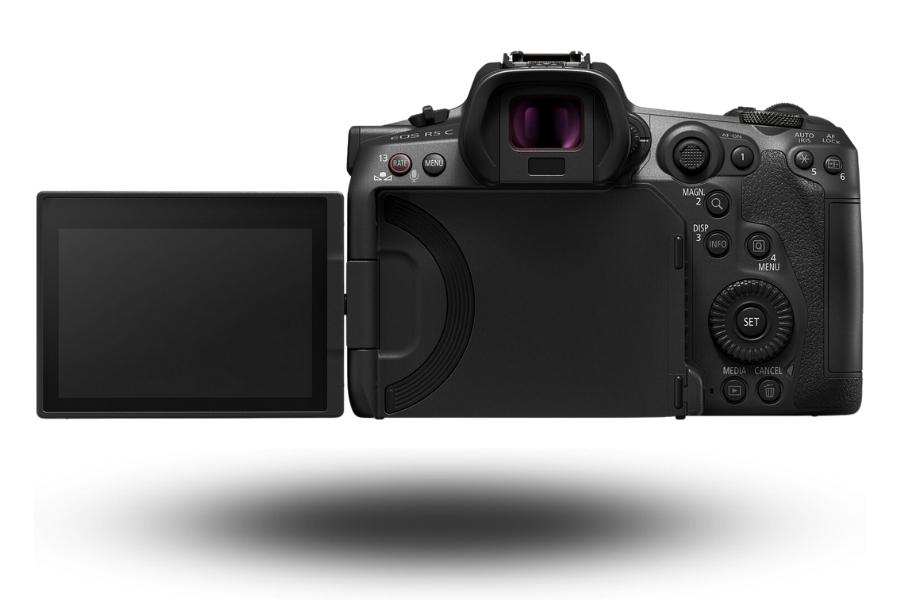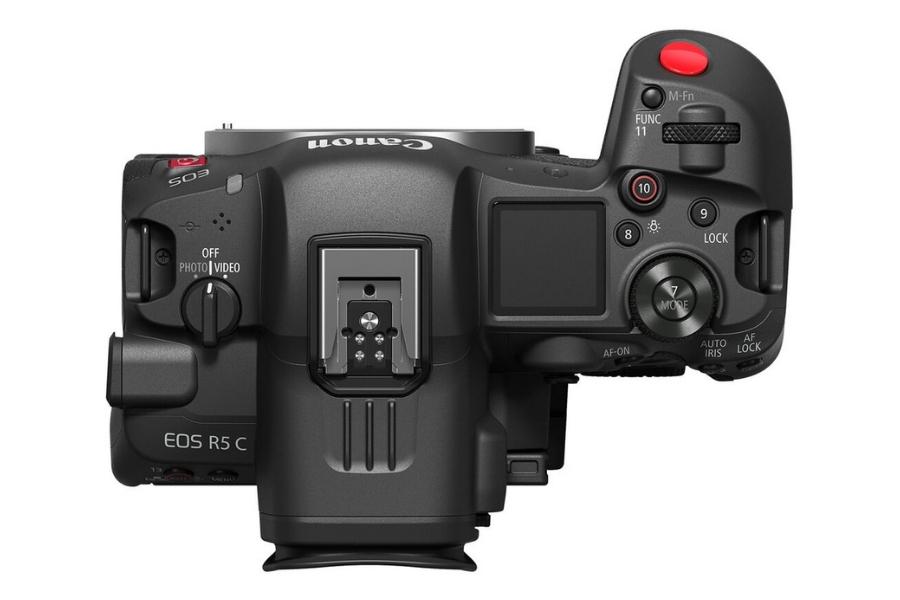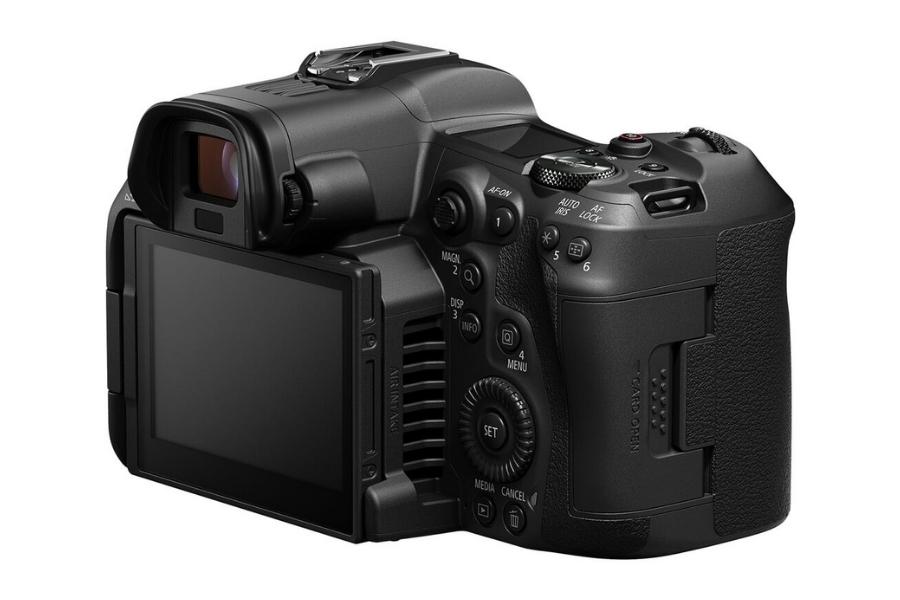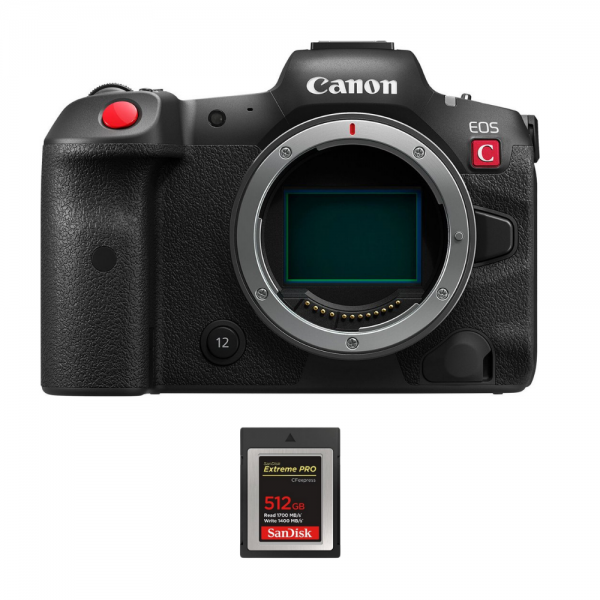- -5%
Canon EOS R5 C Body + 1 SanDisk 512GB Extreme PRO CFexpress Type B
With a Canon EOS R5 C camera that combines the best of the Cinema EOS range with the advantages of the EOS R series, you can shoot 8K/30P videos (60P with external power) or extraordinary 45-megapixel photos.
Canon has unveiled a new hybrid camera in the EOS Cinema range, the Canon EOS R5 C.
It is intended for experienced videographers and professionals, and it can produce 8K 60p RAW videos. It also has the same design as the Canon EOS R5, with an RF mount and an active heat dissipation system to prevent overheating.
It is also capable of taking 45MP photos at 20fps. Here is a summary of all its features.

Canon EOS R5 C: Combination of EOS Cinema and EOS R ecosystems
Announced in July 2020, the Canon EOS R5, the first "consumer" (and photo-oriented) camera capable of capturing 8K RAW, has been talked about since its launch. Unfortunately, the overheating issues of the R5 dampened the enthusiasm of videographers at its inception.
The Canon EOS R5 C is a new "version" of the EOS R5 camera that is expressly focused on video. The Japanese company primarily targets this new model at content creators, independent filmmakers, video reporters, corporate photographers, or directors specializing in events or documentaries.
A large potential target, but the majority of its sales are concentrated on preferred cameras that are both photo and video, like the bodies from Sony and Panasonic (hello GH5 and A7S series).
The new Canon EOS R5 C camera bridges the gap between the Canon Cinema range EOS C and the EOS R ecosystem. This latest body, like the recent EOS C70, uses an RF mount - which definitely positions it.

The EOS R5 with a ventilation system
The EOS R5 and the EOS R5 C are almost identical, with only a few changes. The camera body is identical, being 14.2 centimeters wide and 10.1 centimeters high. However, several modifications have been made to this cinema camera to differentiate it from previous Canon hybrids. The original R branding has been replaced with the C branding that designates cinema bodies.
You'll notice the red shutter button and the small indicator light located in the upper left corner of the body. On the back, you will find at least 13 customizable buttons, to which you can assign one of 80 different functions.
On the top edge, there is a "next-generation" shoe, which we had already seen on the EOS R3. It makes the EOS R5 C compatible with Tascam accessories for high-quality sound recording by adding more connections.
The most significant distinction is at the rear of the device. The new Canon EOS R5 C camera includes an active ventilation system, which is placed at the rear of the device (like the Panasonic S1H), to address the overheating problems that the EOS R5 suffered from.
The EOS R5 C is therefore significantly heavier than its big brother (11.1 cm vs 8.8 cm). Fortunately, the weight is well contained (680 g).
We should be able to film very long sequences using this active ventilation approach. In this regard, consider that the EOS R5 C also removes the 30-minute limit imposed on videos by the (now repealed) European legislation on camcorders.
The EOS R5 C also has many identical components to its big brother, the EOS R5. The 0.5-inch OLED viewfinder with 5.76 million pixels, as well as the tiny control screen on the top edge, are both present.
The 3.2-inch rear screen is again mounted on a ball joint and offers 2.1 million dots, as on the EOS R5. Note that it can be used for better visibility by activating the Zebra mode or the "false colors" control (for easier exposure visualization). A Zebra setting is also accessible.
The EOS R5 C carries over the same three elements as the EOS R5: a 45 MP CMOS sensor (here unstabilized), a Digic X processor, and an RF mount. These three elements allow for recording 8K videos while capturing photos at 70 frames per second in burst mode (with electronic shutter).
Another remarkable feature: the EOS R5 C is a two-headed camera due to its distinct photo and video capabilities. The mode selection dial, for example, must be turned off before switching from photo to video (and vice versa).
Even better: the "photo" firmware and the one for video are completely separate - and different. We find the same photo menu structure as on the EOS R5 (see below). The autofocus modes, however, differ. WiFi is only accessible in photo mode: a separate accessory will be needed to make it work in video mode. same
The distinct separation between photo and video operations within the same camera is surprising, as it gives the impression of having two distinct cameras in one body.

The Canon EOS R5 C records internal 8K 60p RAW videos.
Beyond these factors, the EOS R5 C is a serious combat video camera that can film in 8K RAW at 30p internally - all thanks to the full width of the sensor. This results in 8192 x 4320 pixel photos (oversampling) and a maximum bitrate of 2140 Mbps.
And, if you want to fully exploit this camera's capabilities, it can record up to 60 frames per second... but only if connected to an external power source. Otherwise, recording is possible but without the "motorized" functions (aperture, focus, zoom).
The EOS R5 C also has "crop" modes that allow shooting in Super 35 and Super 16. Note also that the device can produce 4K (or 2K) images by oversampling photos taken with 8K resolution.
Photos are captured in 12 bits and in Cinema RAW Light format, which includes color grading options similar to those of the "classic" Cinema RAW. The latter offers the same degree of color customization as the "classic" Cinema RAW format, but with smaller file sizes. Canon claims to have integrated "three distinct variations of the new RAW format": Raw HQ, Raw Standard, and Raw Light.
However, 8K 60p RAW recording only exists in RAW Light format. The same goes for 8K 25p RAW: it is only accessible in 5.9K at 25p or 3K at 25/50p (in RAW light). In terms of maximum duration, count on 31 minutes for 8K 50p, 63 minutes for 8K 25p (in RAW light), 41 minutes for 8K 25p (in RAW standard), and 38 minutes for 5.9K at 25i (in Raw HQ).
Obviously, the time required to process a low-resolution video is much higher than that needed to process a high-resolution video (up to 8 hours continuously 2.9K at 25p in RAW).
The EOS R5 C also features an HDMI output that allows recording RAW 8K images. The ability to shoot ProRes RAW sequences with the EOS R5 C has been confirmed by the brand, thus an Atomos Ninja V+ can be used to capture ProRes RAW videos with the EOS R5 C.
There are several possibilities for filming.
The EOS R5 C records in 12-bit Cinema RAW Light format as well as in Canon XF-AVC 10-bit format (up to 810 Mbps). MP4 recording is also available (HEVC 4:2:2 10-bit and H.264 4:2:2 8-bit), particularly for creating proxy video files.
Therefore, keep in mind that the EOS R5 C allows for dual simultaneous recordings thanks to the inclusion of an SDXC slot (UHS-II compatible) alongside the CFexpress card slot.
The EOS R5 C will also be capable of capturing slow-motion sequences in 4K at 120p with autofocus, compatible with 4:2:2 10-bit. For color grading, the device offers the possibility to capture in Canon Log 3 and is HDR PQ (Perceptual Quantization) compatible for those who want to shoot in HDR.
However, there are no built-in ND filters; they remain the domain of the EOS C70 device. We can rely on user LUTs to assist you, as well as the ability to design your own custom LUT.
The EOS R5 C is compatible with anamorphic lenses thanks to electronic image de-squeezing in the viewfinder and on connected screens. The three anamorphic formats 2x, 1.8x, and 1.3x are accessible.
The sensor of the EOS R5 C is not stabilized, but the device includes an electronic image stabilizer (IS) in the body that can correct motion blur on 5 axes. A system developed by Canon at the end of 2020 to be used with the RF lenses of the EOS C500 Mark II.
The camera takes advantage of the gyroscopic chip integrated into the lenses to enhance roll and pitch stabilization when shooting with RF lenses. In standard mode, cropping is necessary at 10%, while in "enhanced stability" mode, it is 30%.
The Dual Pixel autofocus of the EOS R5 C is inherited from the EOS R5. The device uses EOS iTR AF X technology in video, with automatic face and head detection and tracking (even when the subject turns their back or is hidden behind an obstacle). The AF should be able to adjust the speed and responsiveness in ten steps each.
In photo mode, however, the system behaves similarly to that of the EOS R5; it detects and tracks subjects' eyes.
Finally, Canon wants to assure its former customers that their EF mount lenses can be used with the EOS R5 C using EF-RF adapter rings.
Therefore, we must note that the camera is compatible with the original EF-EOS R 0.71x adapter ring, which was created to be used with Super 35 mm cameras. Finally, the EOS R5 C becomes the second camera to be compatible with its RF 5.2 mm f/2.8L Dual Fisheye lens and its virtual reality platform.

The EOS R5 C uses the same battery as the EOS R5
In terms of connectivity, the EOS R5 C is not lacking. In addition to the two "classic" 3.5 mm jacks for headphones and microphones, there is a micro-HDMI port and a USB Type C 3.2 port. There is also a Time Code DIN connector and an N3 port for the wired remote, as previously mentioned.
Additionally, there is a multifunctional flash shoe compatible with the Tascam CA-XLR2dc-C adapter to connect four XLR cables for high-quality sound.
The R5C can accommodate CFexpress 2.0 Type B cards in its slot. The presence of an SDXC card slot, as previously mentioned, is a pleasant surprise.
Regarding the battery, the EOS R5 C uses a rechargeable Li-ion LP-E6NH battery, identical to the one used in the EOS R5. Canon has indicated a maximum shooting duration of 50 minutes in 8K RAW 25p or 35 minutes in 4K XF-AVC 50p for now.
However, the device can be used in wired mode with the USB-C PD-E1 adapter or the DR-E6 power coupler (which has the advantage of continuing to power the device even after it is turned on). Note that the BG-R10 grip of the EOS R5 doubles the battery life.
The EOS R5 C is compatible with Bluetooth and Wi-Fi (2.4 and 5 GHz). The video mode requires the use of the WFT-R10 grip, which has Wi-Fi capabilities as well as image transfer to a server.
The EOS R5 C, on the other hand, comes with a new Canon CTM application. Exclusively for iOS, it allows you to connect the camera to your iPhone via USB or Wi-Fi to send videos and metadata to an external server.
The EOS R5 C is also compatible with a "browser remote" feature that allows you to control the camera remotely using its IP address through a basic browser. Finally, the camera is compatible with Canon's image.canon service, created two years ago.







